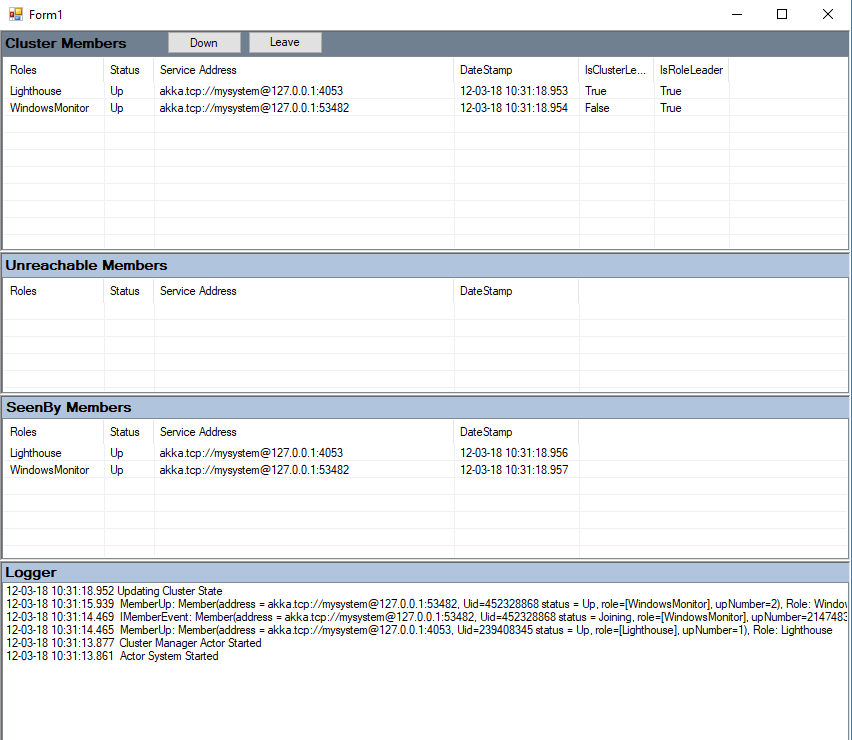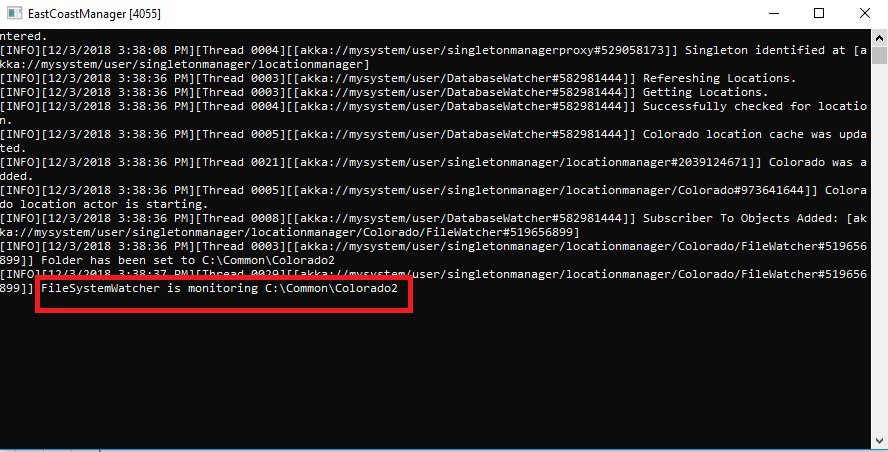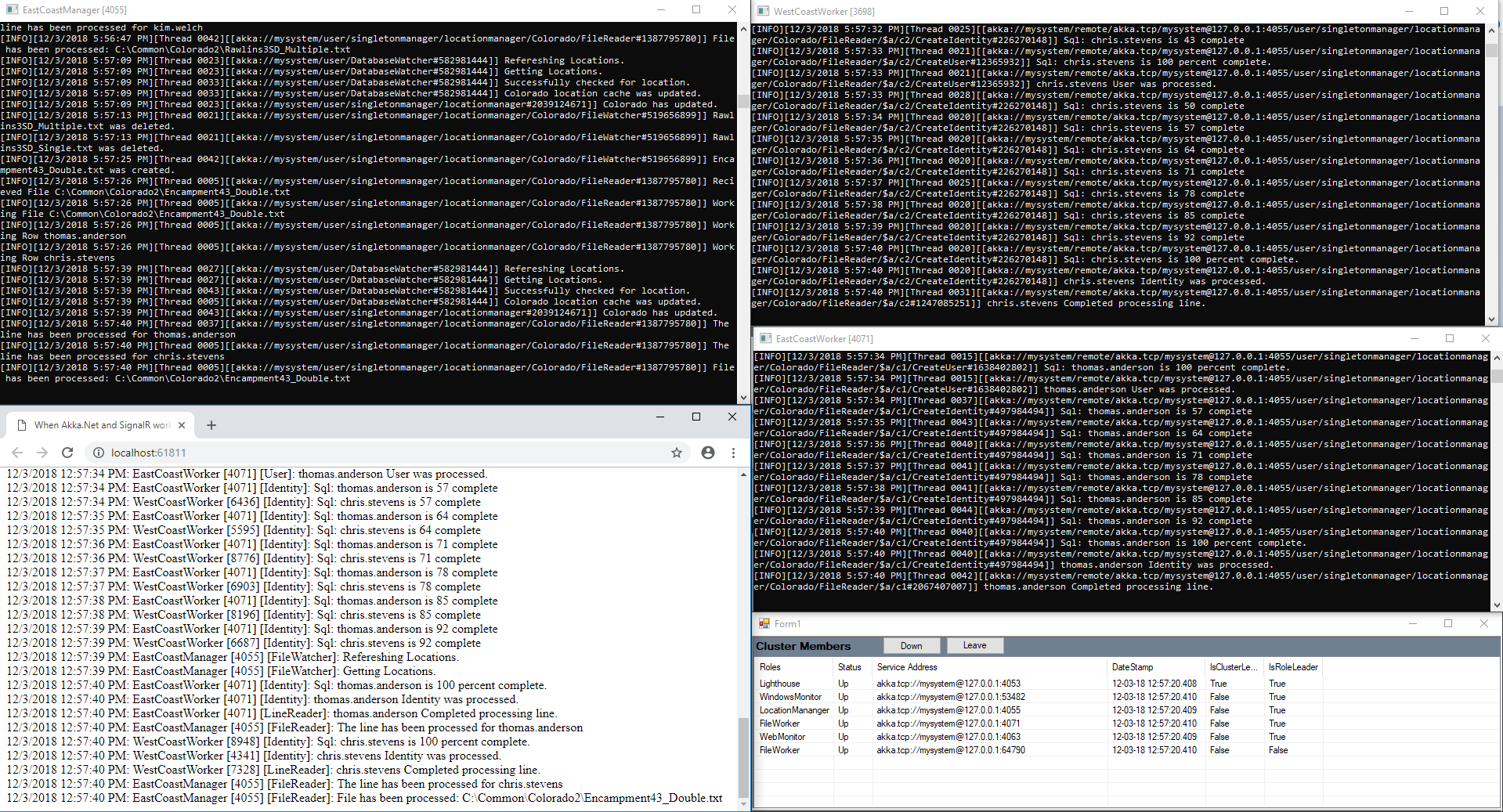Using the actor model we can create powerful concurrent scalable & distributed applications with Akka.Net.
Are you tired of having to put locks on your shared objects and having to manage your threads. Do you want to be able to scale your application up by adding actors and even scale out the cluster by just bringing up another service? Want to make your application real-time by using a message bus? Then hopefully this will show you how to create powerful concurrent & distributed applications using Akka.Net and SignalR.
To get the solution running follow these step to see the action!
-
Install the database - Run the database script Database\BuildAllDatabaseThings.sql. This will setup the following tables and stored procedures.
Tables
dbo.Location - Contains a location (this is just an example and could be anything from a state or a region) dbo.FileSetting - Contains the settings about what folder should be monitored.Store Procedures
dbo.spLocationsWithFileSettings_Get - Gets all the Location and FileSettings. dbo.spLongRunningProcess_ProcessAllThingsMagically - Is used to fake like there is a long running process which raises messages for status update. -
Create a location - Run the database script Database\CreateDummyRecord.sql. This will create a location and file setting for the actor system to use. The settings default is c:\common<LocationName>.
When the Processor project runs and picks up the location it will create the folder. -
Build the solution and launch the following applications.
- Lighthouse
- WindowsMonitor
- WebMonitor
- ProcessorEastCoast
- WorkerEastCoast
-
Viewing the WindowsMonitor you will be able to see all the members join the cluster.
- When the ProcessorEastCoast is initialized; it will tell you that the FileWatcher is monitoring the c:\common<-locationname-> folder. Once this folder is being watch you can copy the ExampleFile/UserFile.txt over. The FileWatcher will recieve an event that the file was created and send a message to the FileReader to start reading this file.
- You will see in the following screen shot all kinds of things going on. The ProcessEastCoast, the manager, is processing one line on the EastCoastWorker and another line on the WestCoastWorker. All the statuses of what the Processor and Workers are doing are being delivered real-time to the WebMonitor. The same message as well as the cluster information is in the log section of the WindowsMonitor.
It is a service-discovery service called a seed node. To maintain fault tolerance you should always run two instances which allows other members to join when needed.
In a highly-available application, it is occasionally necessary to have some processing performed in isolation within a cluster, while still allowing for processing to continue should the designated worker node fail. Cluster Singleton pattern makes this very easy. For example, consider a system that processes a file from a clustered file system or aggregating and then needs to perform some sort of action on these records within the file.
You can see my older version created using DotNet 4.6 and AngularJS. Same concept as this example but dealt with invoices. https://github.com/cgstevens/MyClusterServices
In the FileProcessor example I have created a Singleton Actor. This actor will only exist on either the ProcessorEastCoast or ProcessorWestCoast services. Since all actor systems are hierarchical; lets start are the top.
-
DatabaseWatcherActor This actor is created for the sole purpose to watch the database for changes and tell actors about these changes. It maintains its own cache of the Locations and its FileSettings in this example.
If an actor would like to subscribe to the InboundFolder within the FileSettings model that is a property of the Location model. All it would need to do is send the following tell. This example demonstrates the usage of ActorSelection to tell the DatabaseWatcher that it would like to subscribe to FileSettings.InboundFolder. Then when that property changes this actor is sent those changes.
Context.ActorSelection("/user/DatabaseWatcher").Tell(new SubscribeToObjectChanges(self, _name, "FileSettings.InboundFolder"));This actor also demonatrates the usage of dependency injection.
-
LocationManagerActor This is the Singleton Actor. Its sole purpose is to track
My previous example, MyClusterServices, I created remote actors and then sent a message to them to start working. In this example I want to keep the managing of the work isolated and the real work I want to have a worker. This means that instead of creating this monolitic actors structure remotely; I would create smaller units of work that would be perform remotely.
Since this actor subcribes to all location, the DatabaseWatcher will let the manager know when a location has been addded or removed. This actor will create LocationActor's based on the name of the Location.
-
LocationActor The LocationActor is responsible for managing the FileWatcherActor and FileReaderActor.
-
FileWatcherActor This a single actor that uses the FileSystemWatcher to monitor any changes on the disk. If a file has been created, renamed or deleted it will fire an event to the Actor to handle and determine what to do.
-
FileReaderActor This is a single actor as well. I could create multiple instances of these but I want the order of the files to be processed in order. This actor will work on only a single file at a time.
-
LineReaderActor This actor demonstrates how to create a BroadcastGroup.
I have created 3 actors which I want to perform some sort of work based on the same message._createIdentityRef = Context.ActorOf(Context.DI().Props<CreateIdentityActor>(), "CreateIdentity"); _createUserRef = Context.ActorOf(Context.DI().Props<CreateUserActor>(), "CreateUser"); _createPrivilegeRef = Context.ActorOf(Context.DI().Props<CreatePrivilegeActor>(), "CreatePrivilegeActor"); var workers = new[] { _createIdentityRef.Path.ToString(), _createUserRef.Path.ToString(), _createPrivilegeRef.Path.ToString() }; _workerRouter = Context.ActorOf(Props.Empty.WithRouter(new BroadcastGroup(workers)), "LineReaderGroup");By putting all 3 actors into a group I can send the following message and all 3 different actors will get the same message. They will perform their task and then report back to the LineReaderActor.
// *** BroadCast the message to all worker actors. _workerRouter.Tell(new ProcessLine(record.UserName));We can ask if the _workerRouter has any routes before trying to process the line.
-
CreatexxxActors The CreateIdentity, CreateUser and CreatePrivilege actors all have the IFileProcessorRepository injected so that they can run the LongRunningProcess.
The LongRunningProcess calls dbo.spLongRunningProcess_ProcessAllThingsMagically stored procedure to simulate a database call. By enabling the SqlConnection FireInfoMessageEventOnUserErrors we can use a callback to send the InfoMessages to this actor to relay it on to someone who can do something about it. The stored procedure reports back a percent of completion. This allows me to tell the user a progress real-time.
The worker is a cluster member ready for the manager to task work off to. Demonstrates clean exit when itself is removed from the cluster. The worker will get a set of records and then process those records. Report back what the status of the work back to the Tasker.
The WebMonitor subscribes to the Topic.Status and sends anything messages sent to that Topic to the the SignalR Hub.
Shows the state of the cluster from its point of view. Allows you to tell a member of the clister to leave or be considered down.
Contains the messages, paths and actors that are shared between the above projects.
-
DotNetCore 2.1
https://docs.microsoft.com/en-us/dotnet/core/whats-new/dotnet-core-2-1
-
SignalR
-
NetStandard 2.0
https://docs.microsoft.com/en-us/dotnet/standard/net-standard
-
Akka.Net 1.3.10
Allows you to build powerful distributed event driven systems using actors.
-
Akka.Cluster 1.3.10
https://getakka.net/articles/clustering/cluster-overview.html
-
Akka.Cluster.Tools 1.3.10 - The cluster tools brings us the ability to have the following.
-
FileHelpers 3.3.0
By creating a simple class that describes the file I wanted to import allowed me to easily read the contents of a file. You can see the simple example in the SharedLibrary\Actors\FileReaderActor.cs file.
var engine = new FileHelperEngine<FileModel>(); var records = engine.ReadFile(file.Args.FullPath); -
Knockout 3.3.0
This made it easy to wire up bindings for a quick demo.
You can see this in action in the WebMonitor in the WebMonitor\wwwroot\index.html file.
Main Site: http://getakka.net/
Documentation: http://getakka.net/docs/
The Code (includes basic examples): https://github.com/akkadotnet/getakka.net
Need to ask a question: https://gitter.im/akkadotnet/akka.net
Where do you begin: https://github.com/petabridge/akka-bootcamp
Where do you begin Part2: https://github.com/petabridge/akkadotnet-code-samples
Webcrawler: https://github.com/petabridge/akkadotnet-code-samples/tree/master/Cluster.WebCrawler
Persistent Actors: https://petabridge.com/blog/intro-to-persistent-actors/
Depency Injection: https://getakka.net/articles/actors/dependency-injection.html
Cluster Sharding: https://getakka.net/articles/clustering/cluster-sharding.html
Actor TestKit: https://getakka.net/articles/actors/testing-actor-systems.html
Distributed Pub/Sub: https://petabridge.com/blog/distributed-pub-sub-intro-akkadotnet/



